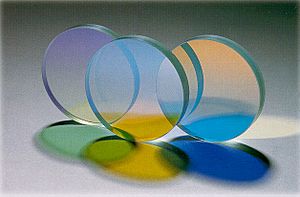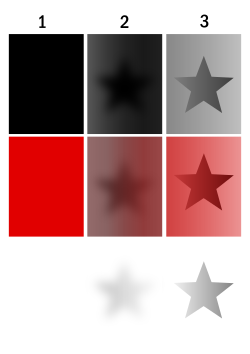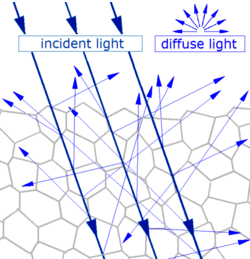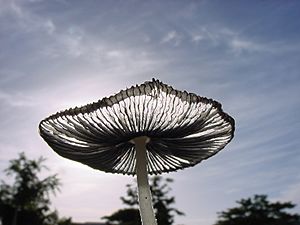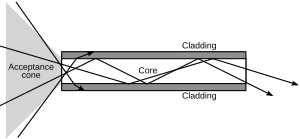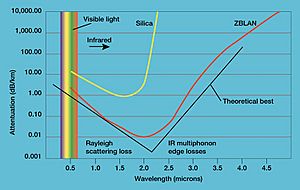Transparency and translucency facts for kids
In science, especially when we talk about light, transparency means that a material lets light go right through it without much scattering. Think of a clear window pane or clean water. You can see clearly through them! When light passes through a transparent material, it follows a straight path, like a ray.
Translucency is a bit different. A translucent material also lets light pass through, but the light gets scattered or spread out. This means you can see light through it, but you can't see clear images. Think of frosted glass or thin paper. You know there's light on the other side, but everything looks blurry. This happens because the material is made of tiny parts that bend and scatter the light in different directions.
The opposite of transparency and translucency is opacity. An opaque material does not let any light pass through it. When light hits an opaque object, it's either absorbed or reflected. You can't see through a brick wall or a wooden door, right? That's because they are opaque.
When light hits any material, it can do a few things:
- It can be reflected (bounce off).
- It can be absorbed (soaked up by the material).
- It can be transmitted (pass through).
How light interacts with a material depends on the type of light (its wavelength) and what the material is made of.
Many liquids, like clean water, are very transparent. They don't have many tiny flaws or different parts inside that would scatter the light.
Animals can also be transparent! This is super helpful for camouflage, especially for marine animals living in the ocean. It's harder to see something that's almost invisible! Many jellyfish are very transparent, which helps them hide from predators in the water.
Contents
What Makes Things Transparent?
Why do some materials let light pass through, while others don't? It all comes down to how light interacts with the tiny parts (atoms and molecules) inside the material.
- Electrons and Light: Light is made of tiny packets of energy called photons. When photons hit a material, they can interact with the electrons inside its atoms. If the electrons can absorb the photon's energy, the light won't pass through. But if the electrons can't absorb the energy (because they don't have the right "energy levels" to jump to), the photon will just pass right through. This is why pure glass is transparent to visible light – its electrons don't absorb visible light photons.
- Vibrations and Heat: Atoms and molecules are always vibrating. When light hits a material, if the light's frequency matches the material's natural vibration frequency, the material will absorb the light's energy. This energy turns into heat. This is how materials absorb infrared light, which we feel as heat. If the light's frequency doesn't match, it passes through or reflects.
Another important factor is how the material is structured:
- Crystal Structure: In materials like crystals, atoms are arranged in a very neat, repeating pattern. This can help light pass through without much scattering.
- Glassy Structure: In glass, atoms are arranged more randomly, but if the material is very uniform, light can still pass through.
- Tiny Flaws: Any tiny cracks, pores, or different-sized parts within a material can scatter light. The smaller these flaws are compared to the light's wavelength, the less scattering happens.
When light hits a rough surface or a material with many tiny internal flaws, it bounces off in all directions. This is called diffuse reflection or light scattering. Most objects we see are visible because they scatter light in this way.
See-Through Ceramics
You might think of ceramics as opaque, like a coffee mug. But scientists have found ways to make some ceramics transparent! This is tricky because ceramics are made of many tiny crystals called "grains," and the boundaries between these grains can scatter light.
To make ceramics transparent, scientists need to make the grains and the spaces between them much, much smaller than the wavelength of visible light (which is about 0.5 micrometers). If these tiny flaws are smaller than about 40 nanometers, light can pass through without much scattering.
Transparent ceramics are being used for amazing things like:
- Strong windows for buildings.
- Special armor.
- Parts for powerful lasers.
- Nose cones for missiles that can "see" heat.
These materials are very strong and can handle high temperatures, making them useful in many advanced technologies.
How Light is Absorbed in Solids
When light hits an object, it usually has many different colors (or frequencies). Objects tend to absorb, reflect, or transmit certain colors more than others. For example, a red apple looks red because it reflects red light and absorbs all other colors of visible light.
Materials that let most light pass through are called optically transparent. Good examples are pure window glass and clean water.
Materials that don't let any light pass through are called opaque. These materials have parts that absorb light. Most materials absorb only certain colors of light. The colors that aren't absorbed are either reflected back or pass through for us to see. This is how we see all the different colors around us!
Light can be absorbed in a few ways:
- Electronic Absorption: This happens when the energy of the light matches the energy needed to make an electron jump to a higher energy level within an atom. This usually happens with ultraviolet (UV) and visible light. For example, most regular glass blocks UV light because its electrons absorb UV photons, but it lets visible light pass through.
- Vibrational Absorption: This happens when the light's frequency matches the natural vibration frequency of atoms or molecules in the material. This usually happens with infrared light. When the light's energy is absorbed, it makes the atoms vibrate more, which we feel as heat.
UV-Vis: Electron Jumps
When a photon of light hits an electron, the electron can absorb the photon's energy and move to a higher energy level. The photon is then gone. What happens next?
- The electron might release the energy as another photon (this is how things like fluorescence work).
- The energy might turn into heat.
- The electron might even break free from the atom (like in the photoelectric effect).
Most of the time, it's a mix of these things. Different materials have different energy levels for their electrons, so they absorb different colors of light. This is why special types of glass can let UV light through, while regular window glass blocks it.
Infrared: Wiggling Bonds
Heat is basically the movement of atoms and molecules. In solid materials, atoms vibrate around their fixed positions. These vibrations happen incredibly fast.
When infrared light hits a material, if the light's frequency matches the natural vibration frequency of the atoms or molecules, those atoms will absorb the light's energy. This energy makes them vibrate more, which means the material gets hotter.
If the infrared light's frequency doesn't match the material's vibration frequency, the light will either reflect off or pass through. If it passes through, it means the material is transparent to that specific infrared light.
Light Guides: Optical Fibers
You've probably heard of fiber optics! These are thin strands of glass or plastic that can carry light over long distances. They work because of a cool trick called total internal reflection.
An optical fiber has a central part called the core and an outer layer called the cladding. The core is made of a material that bends light a little more than the cladding. This difference in how much they bend light (called the refractive index) is key.
When light enters the core of the fiber at a certain angle, it hits the boundary between the core and the cladding. Because the light is moving from a "denser" material (the core) to a "lighter" material (the cladding) and hits at a steep angle, it doesn't escape. Instead, it bounces perfectly back into the core. It keeps bouncing like this all the way down the fiber, carrying information very quickly and efficiently.
Optical fibers are used everywhere, from super-fast internet connections to medical tools that let doctors see inside the body.
Why Light Fades in Fibers
Even in the best optical fibers, some light is lost as it travels. This loss is called attenuation. It's like the signal getting weaker over a long distance.
The main reasons for light loss in optical fibers are:
- Scattering: Even in very clear glass, there are tiny, tiny imperfections or changes in the material's structure. These can scatter a small amount of light, making it go off course.
- Absorption: Sometimes, tiny amounts of other materials, like metals or water, can be left in the glass. These can absorb some of the light's energy.
- Bending and Damage: If a fiber is bent too sharply, or if there are cracks or bad connections, light can leak out.
Scientists are always working to make fibers even clearer so that light can travel even further without losing its strength.
Animals That Are See-Through
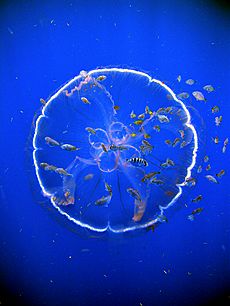
Being transparent is an amazing way for animals to hide! It's like having perfect camouflage. This is especially true for animals that live in the open ocean where there's nowhere to hide behind rocks or plants.
Many marine animals, like jellyfish, have bodies that are mostly water. This makes them very transparent and helps them blend in with the surrounding seawater. It also helps them float! However, having a watery body means they don't have much muscle, so they can't swim very fast. It's a trade-off: great camouflage but slow movement.
Animals need to be more transparent in shallow, bright water to stay hidden. In deeper, darker water, even 50% transparency can be enough to be invisible to predators.
While it's much harder to be transparent in air, some animals on land have found ways to be partly see-through:
- Glass frogs: These frogs from South American rainforests have translucent skin, especially on their undersides, allowing you to see their internal organs!
- Clearwing butterflies: Many butterflies and dragonflies have wings that are mostly transparent. This helps them hide from birds and other predators.
See also
 In Spanish: Transparencia (física) para niños
In Spanish: Transparencia (física) para niños


